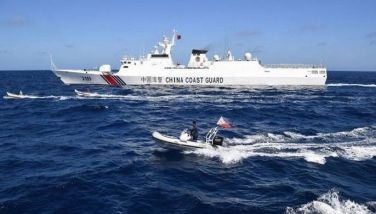Typhoon-triggered heavy monsoon rains shut down Manila, surrounding provinces
MANILA, Philippines -- Heavy monsoon rains brought by typhoon "Maring," which battered the Philippines for four successive days since Sunday, caused massive flooding in Metro Manila and surrounding provinces, killing at least 15 people and forcing thousands of families to flee their homes.
In a press briefing Tuesday, Major Rey Balido, spokesman of the National Disaster Risk Reduction and Management Council (NDRRMC), said that besides the dead, scores were injured while some were reported missing.
The dead included a 5-year-old boy whose house was hit by a collapsed concrete wall. His two adult relatives also were injured, the NDRRMC said.
Authorities said that as of Wednesday morning, the number of affected persons has swelled to more than one million throughout Luzon, the biggest of the three islands in the Philippines.
More than half of Manila was flooded on Tuesday morning although waters in some areas subsided by about 20 percent in the evening, authorities said.
According to the Philippine National Red Cross more than 200,000 people have sought shelter in evacuation centers in Metro Manila.
Reports said that in many coastal towns along swollen Lake Laguna, near Manila, and in food-growing riverside provinces, residents were trapped on rooftops, waded through the streets or drifted on makeshift rafts.
Many residents, however, chose to stay close to their homes for fear they would be looted if they leave. Floodwaters had subsided late Monday but heavy downpour resumed the whole of Tuesday night and Wednesday morning.
For two days, classes and work in government offices were suspended in Metro Manila and surrounding provinces of Laguna and Cavite, which bore the brunt of the heavy downpour. Laguna and Cavite, south of Manila, are where several foreign-funded industrial plants are located.
Financial markets were also closed for two days and more than 160 domestic and international flights at Manila's airports were canceled.
The Office of Civil Defense (OCD) reported Tuesday that in secluded but idyllic town of Sagada near Baguio City, in the mountains far north of Manila, army troops and police had rescued 29 tourists, including 13 Japanese, who were stranded for several hours inside a cave after two days of heavy rains. One Filipino tourist remained missing, the OCD said.
Several dams in Luzon were forced to open their floodgates because of rising waters and thousands of residents downstream were told to evacuate, according to authorities.
The government's weather bureau said that 'Maring' exited Wednesday morning from the Philippines and is now heading toward China. But the bureau said that for the next two days, monsoon rains will continue to affect Luzon, including Metro Manila, and the Visayas in central Philippines.
Flooding has become more frequent in Metro Manila, a metropolis of 12 million people, because of deforestation of surrounding mountains, clogged waterways and canals where large squatter communities live, and poor urban planning.
According to an assessment by the Department of Science and Technology, rainfall reached 600 mm (23.62 inches) in and around Manila Bay on Sunday alone.
Situated right smack in the typhoon belt of the Pacific, the Philippines is battered by an average of 20 typhoons every year that claim hundreds of lives and cause billions in damages.
Tropical storm "Uring", internationally known as "Thelma" was the deadliest cyclone that hit Philippines in recent history. It devastated the provinces of Leyte and Negros in central Philippines in November 1991. "Uring" left 5,000 to 8,000 people dead.
Typhoon "Sendong", internationally known as Washi, which hit the Philippines on Dec. 11, 2011, was the second deadliest cyclone to hit the country. It left 1,010 people dead, 1,603 injured and 46 missing.
On Dec. 2, 2012, typhoon "Pablo", internationally known as Bopha, struck the Philippines, leaving 1,020 dead and 844 missing. The typhoon affected some six million people.
Tropical Storm "Ondoy", internationally known as Ketsana, dumped on Metro Manila and nearby areas at 341 mm -- or a month's worth of rainfall-- in six hours in September 2009, triggering the worst flooding in the capital in decades. The deluge killed 464 people .
Just days after Ondoy, Tropical Depression "Pepeng", internationally known as Parma, hit the country and flooded towns and cities in Northern Luzon, triggering landslides in some areas. It left 492 people dead. Xinhua
- Latest
- Trending






























